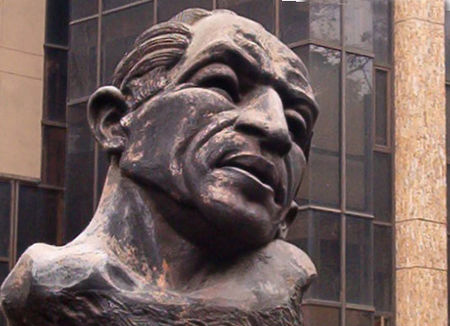
On Apr. 4, peace negotiators of the Revolutionary Armed Forces of Colombia (FARC) who’ve been meeting in Cuba with Colombian government representatives for almost 18 months, called for investigating origins of conflict in Colombia. “Without this input, discussion of Point Five referring to victims will be meaningless. It’s obvious that without establishing the origin of the conflict and its historical truth, there can be no peace.” FARC proposes that the period of historical study start with Law 200 of 1936 that was met with landowner violence lasting until now.“
Law 200, a history lesson
Victory of the Liberal Party in 1930 ended decades of Conservative Party rule. Under Alfonso López Pumarejo, president from 1934 through 1938, the Liberals advanced agrarian reform through Law 200, labor rights, and social programs. Jorge Eliécer Gaitán, leader of the Liberal Party’s left wing and at various times Bogota’s mayor, minister of labor, and education minister, sparked the Party’s response to underclass yearnings. “I am not, personally, me,” he once said, “I am a people.”
April 9, 2014 marks the 66-year anniversary of Gaitán’s assassination in 1948. His story epitomizes history the FARC is looking for and testifies to the emotional pain of unceasing violence. They state that agitation and turmoil prior to Gaitán’s death set the stage for subsequent conflict. Historians see Gaitán was likely to have been elected president in 1950. His death dashed hopes for democratic realization of social reforms, and the opportunity has not returned.
Liberal Party elements headed by Gaitán moved toward political independence as the Conservative Party and old guard Liberal Party leaders mobilized against social reforms. Legislation in 1944 weakened the 1936 land reform law and popular protests mounted. Facing elections in 1946, the Party split. Gaitán campaigned for the presidency as an independent. With the Liberal Party electorate divided, the Conservatives’ Mariano Ospina Pérez became president.
Anti-clerical and business-oriented urban Liberals had, over decades, faced off against Conservatives dedicated to landholding, the military, and the church. Now Liberal Party traditionalists, fearful of popular uprisings, teamed with Conservatives who, also leery of discord and fond of Spain’s General Franco’s Falangist movement in Spain, had moved to the right. The Conservative government set police and the military to terrorizing poor neighborhoods and the countryside. According to one report, “In only two years, more than 15,000 people were assassinated.” Gaitán, sole leader of a now left-leaning Liberal Party, became a lightening rod before a building storm.
Speculation as to responsibility for Gaitán’s killing moved from the deranged, right-wing shooter, to betrayal by Gaitán’s friend Plinio Mendoza, to the CIA, to dark forces within Colombia’s government. For two weeks afterwards, enraged mobs rioted. Over 10 years 200,000 Colombians would die as the army and police fought guerrilla bands. Ex – FARC leader Manuel Marulanda tells how Communist guerrillas, espousing a more coherent political program than that of opportunistic Liberal Party counterparts, took on war that hasn’t ended.
U.S. involvement
When Gaitán died, U.S. Secretary of State George Marshall was in Bogota attending the 9th Pan-American Union Conference. He shepherded the Union’s conversion to the Organization of American States, envisioned as a bulwark against communism in Latin America. Earlier, U.S. intelligence told the Colombian government that communists were inciting anti-government protests. Afterwards, U.S. and Colombian official spokespersons blamed the assassination and rioting on communists. The Colombian government broke relations with the Soviet Union, seen as an instigator of any left movement anywhere in the world during the cold war . U.S. military aid for Colombia’s efforts to eradicate the FARC began the year the communist insurgency was formed, in 1964,
Fifty years later, in March, 2014, General John F. Kelly, head of the U.S. Southern Command, told reporters in Cali that, “We are doing everything we can to help the people and the Armed Forces of Colombia … “The rebels are up against the ropes, almost defeated, and as we say in the United States, we don’t want to take our eyes off the ball.
Socialist thinking in Colombia
Jorge Eliécer Gaitán was a socialist and anti-imperialist. His 1924 doctoral thesis was entitled “Socialist thinking in Colombia.” Responding to the Army’s massacre of 1000 striking banana workers in Santa Marta in 1928, Congressman Gaitán declared, “The Colombian Army has its knee bent before Yankee gold and [enough] arrogance for shooting Colombian children“ The Manifesto of the short-lived, socialist-oriented National Revolutionary Left Union founded by Gaitán in 1933 stated that, “Land must be for those who work it, the large landed estate is a crime, enrichment through exploitation is illicit and criminal, workers must intervene in the management of … factories.”
Colombia’s dark shadow embraced Gaitán as he spoke to followers on February 7, 1948. The funereal tone of his “Oration for Peace” was prophetic. Addressing President Mariano Ospina Pérez, he declared that, a “great multitude flowed into this plaza yet not one cry is heard because within our hearts we listen only to the beat of emotion. Subterranean force is much more powerful during great storms and has power to impose peace when those obliged to do so, don’t. Mr. President: You don’t hear applause here. You only see black flags moving. … We don’t have economic or political theses for you on this occasion…We ask of you deeds of peace and civilization … Sir, stop the violence!”
Photo: Monument to Gaitán, in Medellín, Colombia. Wikimedia Commons










